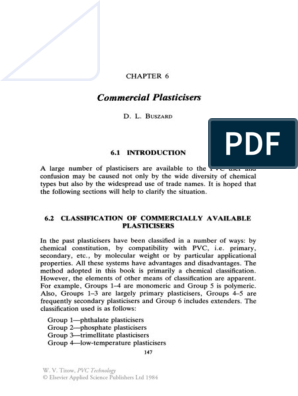MANUFACTURING PROCESS
OF PVC
By Rajat Agarwal
Presented to: Dr. A.N. Sawarkar
�INTRODUCTION
Polyvinyl chloride is third largest and most versatile of
all thermoplastics.
Global production and consumption of Polyvinyl
Chloride PVC in 2010 was approx. 34 million metric
tons.
Polyvinyl chloride (PVC) was first manufactured in
Germany in 1931 as a robust and lightweight new
plastic.
Manufacturing of polyvinyl chloride (PVC) in India
started 60 years ago with the countrys first PVC plant
set up in Mumbai in 1951
�The plant operated by Calico had a capacity of 6000
mt/year.
At present, the Indian PVC industry boasts of a
production capacity of 1.3 million mt/year.
In India the total PVC capacity is expected to reach
1635 KTA by 2016-17.
Reliance Industries Ltd has planned capacity
expansion to 735 KTA by 2016-17 followed by Finolex
at 270 KTA, Chemplast 250 KTA, DCW90 KTA and
Shriram70 KTA.
�WHAT IS PVC ?
PVC is a thermoplastic made of 57% chlorine and 43%
hydrocarbon.
With the addition of plasticizers, fillers,
reinforcements, lubricants and stabilizer, PVC may be
formulated into flexible, rigid, elastomer or foamed
compound.
PVC has outstanding combination of durability,
stability, flame retardancy, heat-electrical insulation
properties, recyclability, excellent long term weather
ability and lower price.
PVC comes in two basic forms: rigid and flexible.
�PROPERTIES OF PVC
Weathering stability. PVC is resistant to aggressive
environmental factors is therefore the material of choice for
roofing.
Versatility.PVC can be flexible or rigid.
Fire protection.PVC is a material resistant to ignition due to
its chlorine content.
Longevity.PVC products can last up to 100 years and even
more.
Hygiene.PVC is the material of choice for medical applications,
particularly blood and plasma storage containers.
Barrier properties.PVC can be made impervious to liquids,
vapors and gases.
Recyclability.PVC is very recyclable, more so than many other
plastics.
Economical efficiency.PVC is the cheapest of large-tonnage
polymers providing many products with the best quality-price
ratio.
�PROPERTIES (CONTD)
Property
Rigid PVC
Flexible PVC
Density(g/cm3)
1.3-1.45
1.1-1.35
Thermal
Conductivity[W/(m.K)]
0.14-0.28
0.14-0.17
Yield Strength[psi]
4500-8700
1450-3600
Youngs Modulus[psi]
490,00
Comprssion Strength
9500
Resistivity
1016
1012-1015
#source: http://en.wikipedia.org/wiki/Polyvinyl_chloride
�APPLICATIONS AND USES
Pipes
Clothing and Furniture
Plasticizers
Flooring
Healthcare
Source: http://www.lenntech.com/polyvinyl-chloridepvc.htm
�MANUFACTURE PROCESS
The suspension polymerization process is most widely
used process to manufacture PVC.
Manufacturing polyvinyl chloride (PVC) is a three-step
process.
Producing
ethylene dichloride (EDC)
Producingvinyl chloride monomer(VCM)
Manufacturing polyvinyl chloride (PVC)
�http://www.pvc.org/upload/images/Chart_02WEB_imagelarge.jpg
�PRODUCING ETHYLENE
DICHLORIDE
Chlorineis extracted from sea salt via
electrolysis.
Ethylene is derived from hydrocarbon raw
materials.
These are reacted to produce ethylene dichloride
(1,2-dichloroethane).
C H + Cl
C2H4Cl2
2 4
2
ethylene + chlorine = ethylene dichloride
�#source: http://guichon-valves.com/wp-content/uploads/dichlorethane-process.jpg
�PRODUCING VINYL CHLORIDE
MONOMER
The ethylene dichloride is then decomposed by heating
in a high temperature furnace or reactor.
C2H4Cl2
C2H3Cl + HCl
ethylene dichloride = vinyl chloride monomer +
hydrogen chloride
The hydrogen chloride is reacted with more ethylene in
the presence of oxygen (oxychlorination). This produces
further ethylene dichloride.
�The resultant ethylene dichloride is decomposed
according to the above equation, and the hydrogen
chloride is again returned for oxychlorination.
2HCl + C H + O
C2H4Cl2+ H2O
2 4
2
C2H3Cl + HCl+ H2O
The overall reaction can be shown by adding together
the above equations:
2C2H4+ Cl2+ O2
2C2H3Cl +H2O
ethylene + chlorine + oxygen = VCM + water
�#source: http://www.asc.co.id/uplimg/Image/edc.jpg
�MANUFACTURING POLYVINYL
CHLORIDE
PVC is made using a process called addition
polymerisation.
This reaction opens the double bonds in the vinyl
chloride monomer (VCM) allowing neighbouring
molecules to join together creating long chain
molecules.
There are four polymerization routes for the
manufacture of PVC.
Suspension
Emulsion
Bulk
Polymerization
Polymerization
or Mass Polymerization
Solution
Polymerization
�SUSPENSION POLYMERIZATION
Vinyl chloride is dispersed into very fine droplets by
vigorous stirring in water.
Protective colloids like polyvinyl, are added to prevent
coalescing of the droplets.
Vinyl-soluble free radical initiators like lauryl are
added and polymerization occurs around 50oC.
The polymer is centrifuged from the reaction mixture,
washed, and dried.
Applications include injection molding and extrusion
(film, tubes).
�EMULSION POLYMERIZATION
Vinyl chloride is emulsified in water by adding
surfactants and emulsifiers with vigorous stirring
Water soluble initiators like persulfates are used for
polymerization.
Purification and drying of the resulting polymer results
in a material that is more expensive than a resin
produced by suspension polymerization.
However, the polymer in the emulsified state (also
known as a plasticol) also can be used.
Examination and surgical gloves use plasticols for their
manufacture.
�BULK POLYMERIZATION
Bulk polymerization is a two-stage process.
In the first stage, pure vinyl chloride monomer is
polymerized up to 10% conversion using monomersoluble free radical initiators.
In the second stage, more monomer is added and the
mixture is polymerized with up to 80-85% yield. The
excess monomer is stripped off using a vacuum and
dried.
PVC obtained from this process is pure, crystal clear,
with a narrow particle size distribution. Applications
include blow molded bottles.
�SOLUTION POLYMERIZATION
In solution polymerization, vinyl chloride is dissolved
in organic solvents and polymerized with an organic
soluble initiator.
The polymer precipitates from the solution is filtered,
washed, and dried.
This process is used to make specialty copolymers with
vinyl acetate.
�ADDITIVES USED
Additive
Properties Achieved
Anti-oxidants &
other stabilizers
Slow down the rate at which the polymer will be
degraded by oxygen, heat, visible light or UV radiation
Compatibilizers
Enable PVC to be mixed with other plastics and helps
plastic recycling
Flame retardants
Reduce flammability of plastic
Pigments
To color the plastic
Plasticizers
To produce flexible and manageable plastic
Impact modifiers
To absorb shock without damage
Fillers
Inexpensive, inert materials that simply add bulk to
the plastic
�DISADVANTAGES OF PVC
Sensitive to UV and oxidative degradation
Limited thermal capability
Thermal decomposition evolves HCI
Higher density than many plastics
�REFERENCES
Vinny R. Sastri, Plastics in Medical Devices, Second
Edition, Applied Science Publishers, 2014, Pages 73120
http://cpmaindia.com/pvc_about.php
http://nptel.ac.in/courses/103107082/module8/lecture3/l
ecture3.pdf
Thornton Joe, Environmental Impacts of Polyvinyl
Chloride (PVC) Building Materials
http://www.pvc.org/
http://www.vinyl.org.au/pvc-safemanufacturing/manufacturing-process
http://www.lenntech.com/polyvinyl-chloride-pvc.htm
http://en.wikipedia.org/wiki/Polyvinyl_chloride

























































































